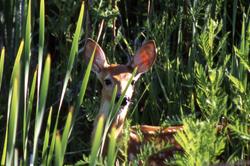White-tailed Deer
Updated: August 12, 2020

The white-tailed deer is one of two species of deer found in Montana. As its name implies, it has a white tail that is raised as a warning waves like a flag when the deer bounds away. Deer are very good runners. They can run at speeds of up to 30 miles per hour.
The color of a deer's upper body and sides both change with the season, from a generally reddish-brown in summer to gray-brown in winter. Its belly and the underside of its tail are completely white, and it has a white patch on the throat. The deer sheds its hair twice a year, its heavy winter coat giving way to a lighter one in spring which is replaced again in early fall.
Whitetails are found in all portions of the state, but they tend to prefer the vegetated areas of coulees along rivers and streams and heavily forested areas of western Montana. Whitetails are what biologists call browsers. They eat leaves, twigs, fruits and berries of shrubby vegetation that grows along stream bottoms or in the under story of the forest.
Woody cover provides the best whitetail habitat, though it is not essential for their survival. Grasslands and marshy areas also provide suitable cover. A deer's home range is usually less than a square mile. On their home range, deer collect in family groups of a mother and her fawns. When a doe has no fawns, she is usually solitary. Male bucks may live in groups consisting of three or four bucks.

Bucks have antlers, which are bone that grows under an outer skin called velvet. When the antlers have finished growing in late summer, the velvet dries up and is rubbed off by the buck to expose the hard antlers underneath. The antlers are used in pushing matches with other bucks hoping to attract a female. The antlers are shed each winter and start growing again in spring. The whitetail buck's antlers typically are formed in the shape of a basket. Points (called tines) branch off the main portion of the antler called the beam.
Deer reproduce quickly. A healthy herd is capable of almost doubling its numbers during one favorable year. Although a series of severe winters may tend to shrink the range of the white-tailed deer in Montana, a few favorable years is all it takes to get the deer population back to normal.
Does commonly have two fawns each spring when they are in a healthy condition, but they may only have one. A fawn is capable of walking shortly after birth, but its movement is limited during the first few days. The mother will leave her fawns well hidden for hours at a time while she feeds. If she has more than one fawn, she will hide them in separate places. A fawn's coat is similar to the adult's but has several hundred white spots, which gradually disappear when the deer is three to four months old.
Updated: August 12, 2020

